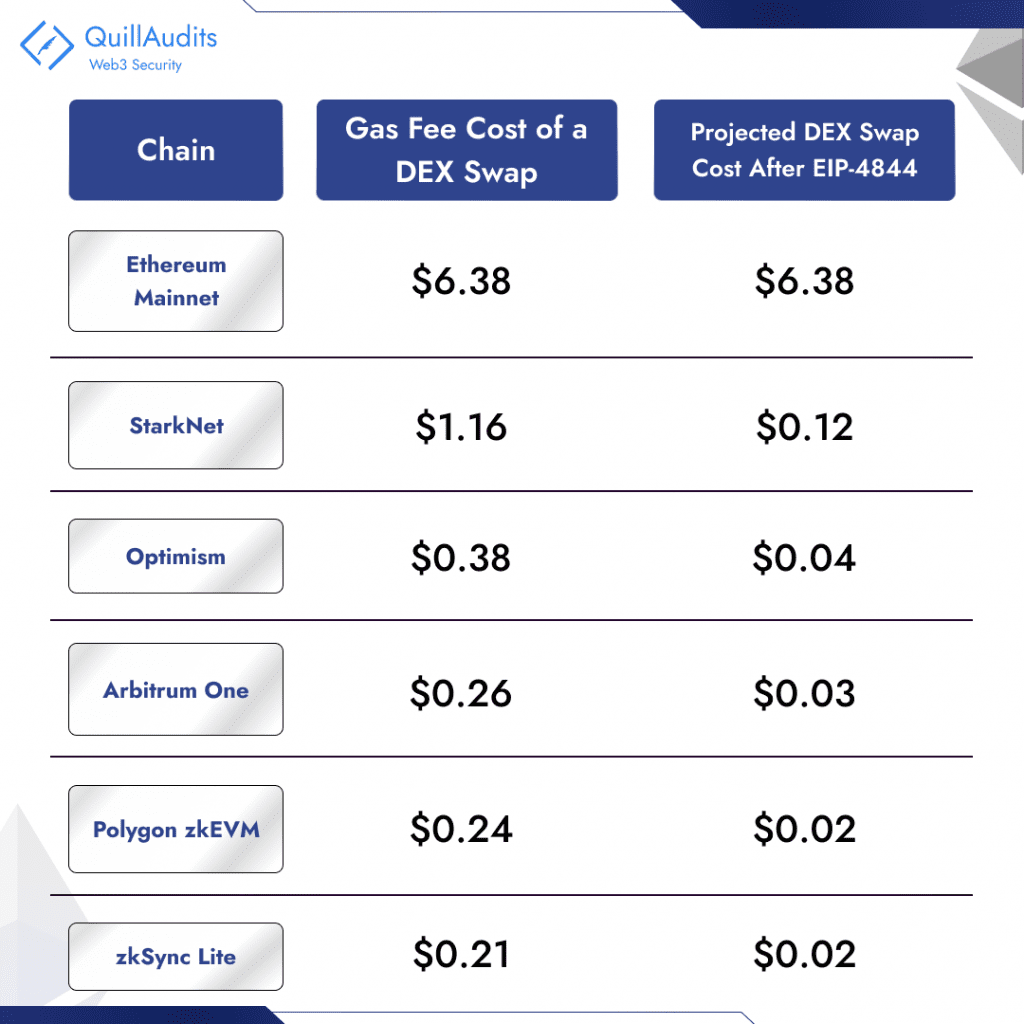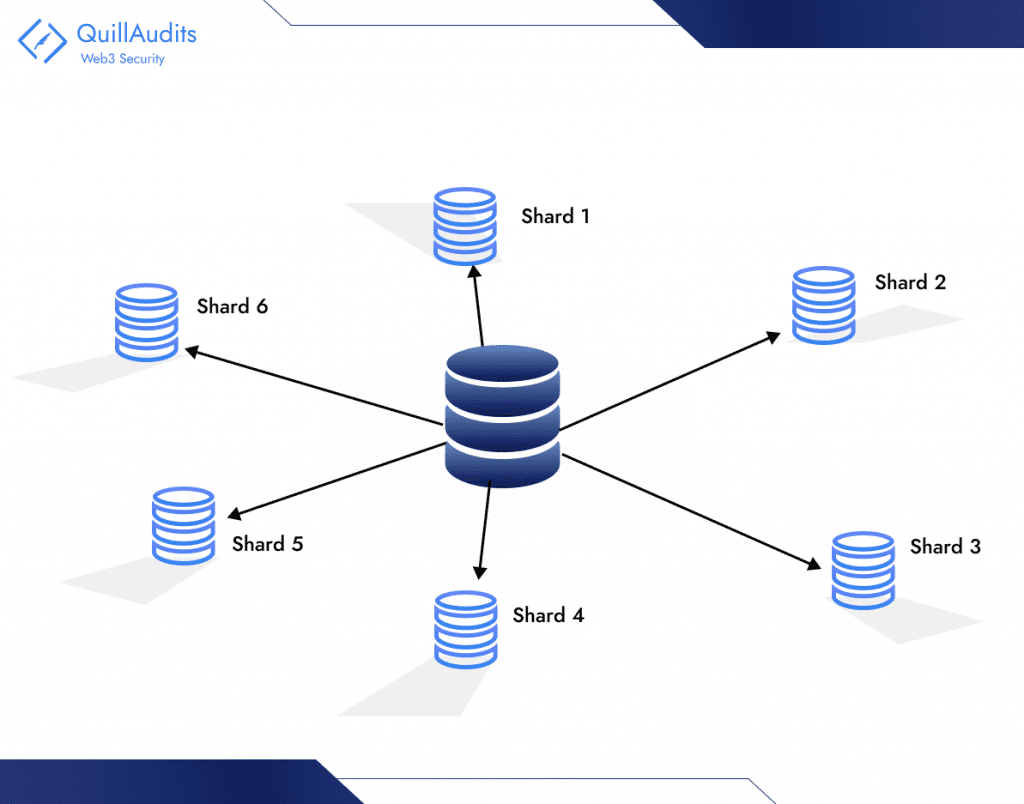Introduction
Ethereum, the driving force behind dApps, has struggled with scalability. High fees and slow processing have limited its potential. They have kept it from a wider audience. DeFi has yet to reach mass adoption. High prices come from intense demand for blockspace. This makes simple transactions, like sending money or buying tokens, hard.
Short-term traders and robots inflate gas prices by bidding in Ethereum’s transaction auctions. And sometimes too many people want to swap NFTs and speculate on the latest meme token simultaneously.
Blockchains need to scale to onboard the next billion users. Layer 2 solutions, like Arbitrum, Optimism, and Base Chain, are key to Ethereum’s scaling. Rollups still have high fees. You pay them to post transaction batches for settlement. They post on Layer 1 of the Ethereum blockchain. And these fees are passed on to users, although some Layer 2s include a subsidy.
EIP 4844, also known as Proto-Danksharding, is emerging as a potential game-changer. EIP 4844 offers a future of seamless, affordable DeFi, NFT, and crypto transactions. This exciting upgrade introduces “blobs,” temporary storage spaces for large data chunks. Imagine taking the strain off a crowded marketplace. You would do this by moving bulky items to a temporary storage facility. That’s what Proto-Danksharding does for the Ethereum blockchain, leading to:
Layer 2 solutions, like Arbitrum or Optimism, could have lower fees,thanks to Proto-Danksharding. This would make DeFi more accessible.



The main chain will have less data. This will let it fit more transactions per block making transactions faster and cheaper.
Proto-Danksharding can boost DeFi’s growth and inclusivity. It does this by cutting transaction costs, overcoming a big adoption hurdle.
Join us in exploring EIP 4844 (Proto-Danksharding). It’s a solution for Ethereum’s scalability problems. It unlocks exciting possibilities for users and developers.
What is Danksharding?



Sharding is about breaking down the Ethereum network. It creates smaller, manageable parts, or “shards.” Each shard operates alone. It has its own set of validators and states. This setup allows for parallel processing of transactions and data. Think of it as a team. They work on different parts of a project at the same time. They are efficient and effective. Unsharding is the reverse process. It reunites shards to form a coherent, unified Ethereum network.
Danksharding represents the latest plan for implementing sharding on the Ethereum platform.It incorporates Binary Large Objects (BLOBs), sizable data entities, to significantly boost transaction throughput. The aim is to reduce transaction expenses within the Ethereum network.
Known for its potential to address scalability issues, Danksharding is anticipated to elevate Ethereum’s transaction processing rate to approximately 100,000 transactions per second (tps). It stands as a significant step forward in realizing the scalability objectives of Ethereum rollups.
What is proto-danksharding (aka. EIP-4844)?
Proto-danksharding (EIP-4844) outlines key elements of Danksharding without implementing sharding. It includes the essential logic and structural components such as transaction formats and verification rules. In proto-danksharding, validators and users must validate the availability of the entire dataset directly.
One key innovation introduced by proto-danksharding is a new transaction type known as a blob-carrying transaction. The transaction type is similar to a standard one but has an additional piece of data called a blob.
Blobs are significantly large, approximately 125 kB, and can be more cost-effective compared to similar amounts of calldata. The EVM can’t access blob data; it can only observe a commitment to it. In proto-danksharding, the data bandwidth is targeted to be 1 MB per slot instead of 16 MB since validators and clients still need to download complete blob contents.
Scalability improves as blob data doesn’t compete with gas usage of existing Ethereum transactions. This intermediate solution, represented by EIP-4844, aims to optimize L2 transactions. It will make them significantly cheaper for users. It focuses on cutting transaction costs.
What are blob transactions?
EIP-4844 is a key part of the Ethereum Dencun Upgrade. It adds ‘blobs’ to boost network function. Here’s a simplified breakdown:
Blob Overview :- Blobs are big data packets in Ethereum’s blockchain. They make data management and storage better.
Blob Size: Each blob is about 125 kB. This allows for more data processing than typical Ethereum transactions.
Storage Approach: Blobs employ KZG cryptographic commitments for efficient storage. They offer a cost-effective data storage solution on the Ethereum network.
Ethereum Role: Blobs mainly help Layer 2 rollup solutions. They aim to cut transaction costs and ease network congestion. This will improve Ethereum’s scalability.
EVM Accessibility: Unlike normal Ethereum transactions, blob data is not directly accessible by the EVM. This shows their special role in data storage in Ethereum.
How does EIP-4844 work to reduce gas fees?
Ethereum’s EIP-4844, also known as Proto-Danksharding, tackles high gas fees with a multi-pronged approach:
- Blob Transactions: These transactions carry large data chunks (“blobs”) separately from regular transactions. Blob storage in EIP-4844 reduces cost by separating data from the main chain, freeing up space and lowering competition.
- Fixed Data Bandwidth: EIP-4844 caps block size despite cheaper storage to prevent data overload. This prevents situations where cheaper blobs lead to massive block sizes and even higher gas fees.
- Separate Storage: Unlike regular transaction data, blobs are stored outside the main Ethereum chain. This reduces the strain on the network and further decreases overall storage costs.
By implementing these features, EIP-4844 addresses the immediate problem of high gas fees. EIP-4844 prepares for sharding, paving the way for a more scalable Ethereum.
Proposer/Builder Separation (PBS)
EIP-4844 introduces Proposer/Builder Separation (PBS) to manage the system without overwhelming validators. In this approach, specialized actors, called block builders, compete to decide the slot’s contents.
Following this, the proposer selects the valid header with the highest bid. Gas and blobs are segregated, each assigned unique gas prices and limits. Only the block builder processes the block entirely, while others can efficiently verify it through data sampling. Thus, EIP-4844 advocates for distinct fee markets for data and execution.
What are the Benefits Of EIP-4844?
Reduction in Gas Fees: The dramatic reduction of gas fees is at the heart of EIP-4844’s goals. EIP-4844 reduces Ethereum transaction costs, particularly benefiting users of layer-2 solutions. This move enhances Ethereum’s overall accessibility.
Enhanced Scalability: EIP-4844 introduces blob transactions to increase Ethereum’s transaction capacity dramatically. This scalability paves the way for Ethereum’s billion-user vision.
Impact on Rollups and Scalability: EIP-4844’s blob-carrying transactions are set to revolutionize scalability. Blob transactions bypass Layer 1 gas competition, enhancing Ethereum’s scalability. This results in more cost-effective roll-up pricing and reduced overall transaction costs. EIP-4844 introduces 1MB block sizes and blob transactions, boosting scalability and reducing rollup fees.
Substantial Fee Reductions for Rollups: EIP-4844’s blob transactions and unified fee market could dramatically reduce rollup costs. This cost efficiency benefits users and encourages wider adoption of Ethereum’s layer-2 solutions.
Global Transaction Network Scalability: It paves the way for Ethereum to manage a global transaction network effectively. This optimizes data, boosting scalability for diverse applications and users.
EIP-4844 Timeline for Implementation
The Ethereum Dencun upgrade (EIP-4844) scheduled for March 13th is expected to significantly reduce rollup costs by introducing blobs, which is anticipated to minimize L2 gas costs significantly.
The testing phase on the Goerli testnet will play a crucial role in determining the final rollout date, ensuring that the upgrade is robust and stable before its full implementation on the Ethereum network.
Conclusion
EIP-4844, or Proto-Danksharding, is a big stride. It tackles Ethereum’s issues with too many transactions and high fees. It introduces a new approach to blob-carrying transactions. This upgrade will cut gas costs and raise transaction speed. This opens the door for cheaper Layer 2 solutions. It also marks a new era of growth. This growth is for decentralized applications, DeFi platforms, and the wider Ethereum ecosystem. The Ethereum Cancun Upgrade, centered on EIP-4844, highlights the community’s dedication to an inclusive, scalable blockchain infrastructure. The future of Ethereum looks brighter than ever. It promises to unlock new possibilities for users and developers. It will bring us a step closer to mass adoption of blockchain technology.
FAQs
- What is the role of Proposer/Builder Separation (PBS) in EIP-4844?
Proposer/Builder Separation (PBS) in EIP-4844 separates block building (creating the block content) from block proposing (submitting it for validation). This:
Improves efficiency: Validators only need to verify blocks, not build them.
Maintains decentralization: Proposers compete for the right to propose blocks.
Allows specialization: Block builders can focus on efficient block construction.
- What are blobs?
Blobs are large data packets (around 125 kB) that can be attached to transactions in EIP-4844. They are stored separately from the main chain, making transactions cheaper and reducing network congestion.
- How does EIP-4844 benefit rollups?
Layer 2 rollups are expected to see significant benefits from EIP-4844:
Lower fees: Blob transactions bypass competition for gas on Layer 1, leading to cheaper rollup transactions.
Increased scalability: EIP-4844’s improvements pave the way for increased transaction capacity, benefiting rollups and the entire network.
- What is KZG’s Cryptographic commitment ?
KZG commitments are a cryptographic tool that allows you to prove information about a hidden piece of data. They use the mathematical concept of polynomials to make these proofs compact and efficient.






















